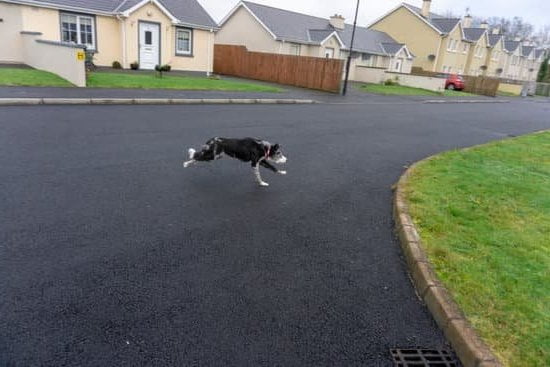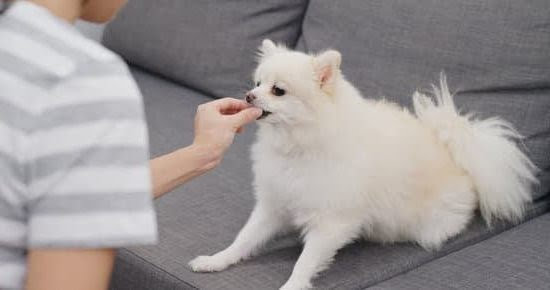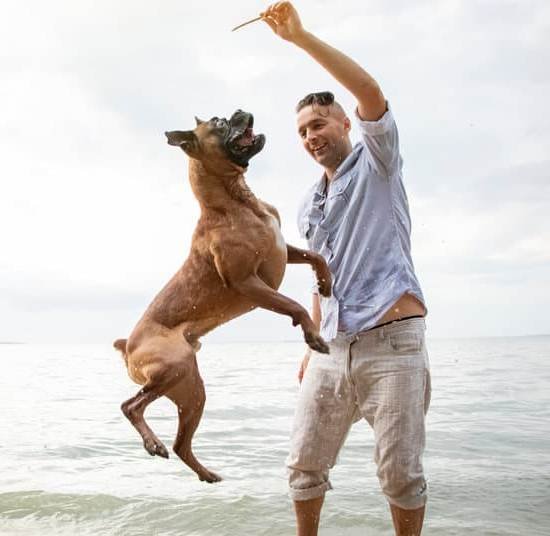Are you wondering how to train your dog to use buttons for communication? Communication buttons have become a popular tool for pet owners who wish to improve their understanding of their dog’s needs and desires. In this article, we will explore the concept of communication buttons for dogs and provide a comprehensive guide on how to train your dog to use them effectively.
Teaching your dog to use communication buttons can have numerous benefits for both you and your furry friend. By learning to express themselves through these buttons, dogs can communicate their needs, wants, and emotions more effectively. This not only strengthens the bond between pet and owner but also provides mental stimulation and enrichment for the dog.
Before beginning the training process, it is important to choose the right communication buttons for your dog. There are various types of buttons available, each with different features and purposes. In the following sections, we will delve into the step-by-step process of introducing these buttons to your dog, along with training tips and techniques for effective learning.
The Benefits of Teaching Your Dog to Use Buttons for Communication
Teaching your dog to use buttons for communication can have numerous benefits for both you and your furry friend. By introducing this innovative method of communication, you can enhance your dog’s ability to express their needs, emotions, and desires, ultimately strengthening the bond between you and your pet.
Enhanced Communication
One of the primary benefits of teaching your dog to use buttons is the improvement in communication between you and your pet. Dogs are intelligent creatures with the capacity to understand a wide range of words and phrases. By incorporating communication buttons into their training, you can provide them with a more efficient way to convey their thoughts and needs. This can lead to a deeper understanding of your dog’s behavior and emotions, allowing for better empathy and care.
Promotes Mental Stimulation
Incorporating buttons into your dog’s training routine can also provide mental stimulation, which is crucial for their overall well-being. Learning new skills, such as pressing specific buttons to communicate, can engage your dog’s problem-solving abilities and cognitive function. This mental exercise can prevent boredom, anxiety, and other behavioral issues that may arise from lack of mental stimulation.
Strengthens Bond With Your Dog
Teaching your dog to use buttons for communication creates an opportunity for increased interaction between you and your pet. As you work together during training sessions, you’ll build a stronger bond based on trust and understanding. Your dog will learn to rely on you as they navigate through the process of using the buttons effectively, ultimately leading to a deeper connection between the two of you.
By recognizing these benefits, it becomes clear how valuable it can be to train your dog to use communication buttons. The following section will provide a step-by-step guide on how to introduce these buttons to your pet successfully.
Choosing the Right Communication Buttons for Your Dog
When it comes to choosing the right communication buttons for your dog, there are a few important factors to consider. The first step is to select buttons that are durable and easy for your dog to press. Look for buttons with a non-slip surface and a design that can withstand daily use from your pet.
Additionally, it’s crucial to choose buttons that are large enough for your dog’s paw or nose to comfortably press. Some dogs may have difficulty using smaller buttons, so be sure to take your dog’s size and physical capabilities into account when selecting the buttons.
Another consideration is the number of buttons you want to start with. For beginners, it’s best to begin with just a few basic communication buttons such as “eat,” “play,” “outside,” and “water.” As your dog becomes more familiar with using the buttons, you can gradually introduce additional buttons for more complex communication.
When deciding on the type of communication buttons to use, you also have the option of choosing between traditional physical buttons or electronic touchpad devices. Electronic touchpad devices offer the benefit of recording personalized voice messages for each button, adding an extra layer of customization to your dog’s communication experience.
By carefully considering these factors and selecting the appropriate communication buttons for your dog, you are setting the stage for successful training on how to train my dog to use buttons effectively.
Step-by-Step Guide on How to Introduce the Buttons to Your Dog
Introducing communication buttons to your dog can be an exciting and rewarding process. By teaching your furry friend to use buttons, you are opening up a whole new world of communication and understanding between you and your pet. Here is a step-by-step guide on how to introduce the buttons to your dog:
1. Choose the right buttons: The first step in introducing communication buttons to your dog is selecting the right ones for your pet. Look for durable buttons that can withstand repeated use, and consider using buttons with different colors or symbols to represent different concepts or actions.
2. Establish basic understanding: Before introducing the communication buttons, it’s important to ensure that your dog has a basic understanding of verbal commands. Start by reinforcing simple commands such as “sit,” “stay,” and “come” before moving on to introducing the buttons.
3. Introduce one button at a time: Start by introducing one button at a time to avoid overwhelming your dog. Place the button in an easily accessible location and encourage your pet to press it when they want something, such as going outside or getting a treat.
4. Reinforce learning through repetition: Consistency is key when training your dog to use buttons. Use positive reinforcement such as treats or praise when your pet successfully uses the button, and be patient as they begin to understand its purpose.
5. Gradually introduce more buttons: Once your dog has mastered using one button, gradually introduce additional buttons for different concepts or actions. Repeat the same process of reinforcement and patience as you expand their vocabulary.
By following these steps, you can help your dog learn how to communicate using buttons effectively, strengthening the bond between you and your furry companion while also improving their overall quality of life.
Training Tips for Teaching Your Dog to Use the Buttons Effectively
Teaching your dog to use communication buttons can be a fun and rewarding experience for both you and your pet. However, it’s important to approach the training process with patience and consistency. Here are some training tips to help you teach your dog to use the buttons effectively.
First, start by introducing one or two buttons with simple commands such as “outside,” “play,” or “food.” Use treats and positive reinforcement to encourage your dog to press the button when they want something. Repeat the command every time you press the button, so your dog associates the word with the action.
Consistency is key when teaching your dog to use buttons. Make sure everyone in the household uses the same commands and reinforces them with treats and praise. This will help your dog understand what each button means and how to communicate their needs effectively.
Another important tip is to keep training sessions short and frequent. Dogs learn best through repetition and consistency, so practicing for a few minutes several times a day is more effective than one long session. Be patient and celebrate small victories along the way, as some dogs may take longer to grasp the concept of using buttons for communication.
| Training Tip | Description |
|---|---|
| Start with simple commands | Introduce one or two buttons with easy commands like “outside” or “food.” |
| Be consistent | Use the same commands and reinforce them with treats and praise from everyone in the household. |
| Short, frequent training sessions | Practice for a few minutes multiple times a day for better results. |
These training tips will help you effectively teach your dog how to use buttons for communication, strengthening your bond and understanding of each other. Keep in mind that every dog learns at their own pace, so be patient, stay consistent, and enjoy the journey of learning this new form of communication with your furry friend.
Common Challenges and How to Overcome Them During the Training Process
When training your dog to use communication buttons, there are some common challenges that you may encounter. However, with patience and the right approach, these challenges can be overcome to help your dog effectively communicate using the buttons.
Overcoming Confusion
One of the main challenges during the training process is confusion. Your dog may initially struggle to understand the purpose of the buttons and how to use them. To overcome this challenge, it’s important to start with simple, clear commands and consistently reinforce their use. Use treats or positive reinforcement to encourage your dog when they successfully use a button to communicate.
Addressing Limited Vocabulary
Another challenge is limited vocabulary. Initially, your dog may only understand a few words or commands, making it difficult for them to express themselves using the buttons. To overcome this, introduce one new button at a time and focus on reinforcing one concept until they grasp it before adding more buttons. This gradual approach will help them expand their vocabulary over time.
Persistence and Patience
Training your dog to use communication buttons requires persistence and patience. It’s important not to get discouraged if progress is slow or if your dog seems resistant to using the buttons at first. Consistent practice and positive reinforcement will help your dog understand and become comfortable with using the buttons for communication.
By addressing these common challenges with understanding, limited vocabulary, and patience, you can successfully train your dog to use communication buttons effectively in daily interactions. Remember that every dog learns at their own pace, so stay patient and consistent in your training approach.
Real-Life Success Stories of Dogs Using Communication Buttons
Communication buttons for dogs have gained popularity in recent years as a way to better understand and communicate with our furry friends. Many pet owners have found success in teaching their dogs to use communication buttons, and there are numerous heartwarming stories of dogs effectively using these buttons to express their needs and emotions.
Here are some real-life success stories of dogs using communication buttons:
- Max, a Labrador Retriever, successfully learned how to use communication buttons to ask for food, water, and even playtime. His owner reported that Max’s overall behavior and demeanor improved after learning to use the buttons.
- Sadie, a Border Collie mix, amazed her owner by using communication buttons to convey when she was feeling anxious or scared. This allowed her owner to provide the necessary comfort and support.
- Rex, a Golden Retriever, was able to use communication buttons to indicate when he wanted to go for a walk or when he needed to go outside to relieve himself. This not only made life easier for Rex but also strengthened the bond between him and his owner.
These inspiring stories demonstrate just how impactful teaching your dog to use communication buttons can be. It not only enhances their ability to express themselves but also strengthens the bond and understanding between you and your pet.
By introducing communication buttons into your dog’s training regimen, you too can experience the joy of seeing your furry companion effectively communicate their needs and emotions.
Advanced Training Techniques to Expand Your Dog’s Communication Skills
Once your dog has mastered the basic communication buttons, you can start introducing more advanced training techniques to expand their communication skills. This can include adding more buttons for different words or phrases, teaching them to combine buttons to form more complex messages, or even introducing grammar concepts such as past or future tense.
One advanced technique is to teach your dog the concept of categories by using different sets of buttons for activities, objects, and feelings. For example, you can have a set of buttons for “play,” “walk,” “food,” and another set for “ball,” “leash,” “treat.” This will enable your dog to express their specific needs and desires more accurately.
Additionally, you can incorporate storytelling into your dog’s training by creating sequences of buttons that represent a narrative. By teaching your dog the order in which certain actions occur and allowing them to communicate this through the buttons, you are strengthening their understanding of language and how it relates to real-life situations.
Furthermore, you can introduce more abstract concepts such as prepositions or adjectives using visual aids and consistent reinforcement. This will challenge your dog’s cognitive abilities and enhance their language skills beyond basic communication needs. With patience and persistence, these advanced training techniques can significantly improve your dog’s ability to effectively communicate using buttons.
| Training Technique | Description |
|---|---|
| Categories | Teach your dog different sets of buttons for activities, objects, and feelings. |
| Storytelling | Create sequences of buttons that represent a narrative for your dog to communicate. |
| Abstract Concepts | Introduce prepositions or adjectives using visual aids and consistent reinforcement. |
Conclusion
Teaching your dog to use communication buttons can have a tremendous impact on your relationship and communication with your pet. By understanding the concept of communication buttons for dogs and the benefits of incorporating them into your training, you can greatly improve your ability to understand and connect with your furry friend.
In this article, we have discussed the importance of teaching your dog to use buttons for communication, as well as the process of choosing the right communication buttons for your pet. We have also provided a step-by-step guide on how to introduce the buttons to your dog, along with training tips for effective implementation. Additionally, we addressed common challenges during the training process and shared real-life success stories of dogs using communication buttons.
As you continue to train your dog to use buttons for communication, it’s important to remember that each pet learns at their own pace. It’s essential to stay patient and consistent in your training efforts, utilizing positive reinforcement and rewarding progress along the way. With dedication and perseverance, you can expand your dog’s communication skills through advanced training techniques and ultimately strengthen the bond between you and your beloved companion.
In conclusion, by teaching your dog to use buttons for communication, you are not only providing them with a valuable means of expressing their needs and desires but also enhancing the depth of understanding and connection in your relationship. So, if you’ve ever wondered “how to train my dog to use buttons“, now is the perfect time to start this rewarding journey towards improved communication with your furry friend.
Frequently Asked Questions
How Do You Train a Dog to Use a Button?
Training a dog to use buttons involves consistent and patient reinforcement. Start by teaching the dog to associate a specific word with a button, then encourage them to press it when they want something. Positive reinforcement is key!
Is It Hard to Teach Dogs to Use Buttons?
Teaching dogs to use buttons can be challenging, as it requires consistent training and communication. Some dogs may pick it up quickly, while others may take longer to understand the concept. It largely depends on the individual dog’s ability to learn and communicate.
How Long Does It Take to Train a Dog to Use Buttons to Talk?
The time it takes to train a dog to use buttons varies from dog to dog. Some may grasp the concept within a few weeks of consistent training, while others may take months. It depends on the dog’s intelligence, learning ability, and the owner’s dedication to training.

Welcome to the blog! I am a professional dog trainer and have been working with dogs for many years. In this blog, I will be discussing various topics related to dog training, including tips, tricks, and advice. I hope you find this information helpful and informative. Thanks for reading!





